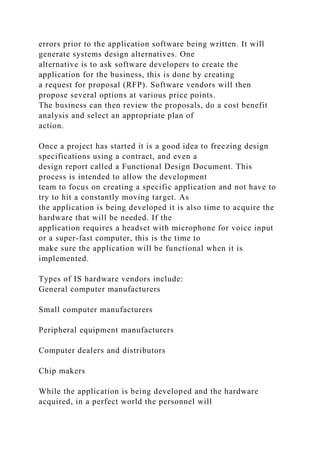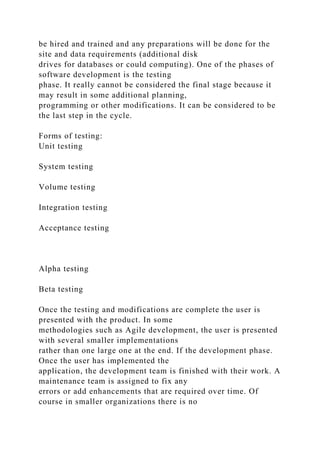Management Information Systems – Week 7 Lecture 2Developme.docx
- 1. Management Information Systems – Week 7 Lecture 2 Development & Improvement Chapter 13 Systems Development: Design, Implementation, Maintenance, and Review You have learned about information systems and seen a little about how the project is run to create a new system. This week you will focus on the actual systems design process. This will help you whether you become a programmer, systems analyst or are a department manager. There are countless articles on this subject on the internet and some great YouTube videos so take a moment to do some extra research and learn more about systems development. When an IS manager sits down to design a system they look at several areas and have many special tools at their disposal. A systems engineer or senior developer will first look at the logical design. This usually means that they look at the user request and determine what they really mean! Once they have clarification they will create a physical design. This might be object-oriented (using code that has already been created) or mock ups showing interface design and controls. This is sometimes called storyboarding. This image is an example of creating a new user interface: System design time is an investment for the business, it will help by preventing, detecting, and correcting
- 2. errors prior to the application software being written. It will generate systems design alternatives. One alternative is to ask software developers to create the application for the business, this is done by creating a request for proposal (RFP). Software vendors will then propose several options at various price points. The business can then review the proposals, do a cost benefit analysis and select an appropriate plan of action. Once a project has started it is a good idea to freezing design specifications using a contract, and even a design report called a Functional Design Document. This process is intended to allow the development team to focus on creating a specific application and not have to try to hit a constantly moving target. As the application is being developed it is also time to acquire the hardware that will be needed. If the application requires a headset with microphone for voice input or a super-fast computer, this is the time to make sure the application will be functional when it is implemented. Types of IS hardware vendors include: General computer manufacturers Small computer manufacturers Peripheral equipment manufacturers Computer dealers and distributors Chip makers While the application is being developed and the hardware acquired, in a perfect world the personnel will
- 3. be hired and trained and any preparations will be done for the site and data requirements (additional disk drives for databases or could computing). One of the phases of software development is the testing phase. It really cannot be considered the final stage because it may result in some additional planning, programming or other modifications. It can be considered to be the last step in the cycle. Forms of testing: Unit testing System testing Volume testing Integration testing Acceptance testing Alpha testing Beta testing Once the testing and modifications are complete the user is presented with the product. In some methodologies such as Agile development, the user is presented with several smaller implementations rather than one large one at the end. If the development phase. Once the user has implemented the application, the development team is finished with their work. A maintenance team is assigned to fix any errors or add enhancements that are required over time. Of course in smaller organizations there is no
- 4. hand off, the development team and the maintenance team may in fact be the same people. The maintenance phase is sort of like the senior citizen phase of an application’s life cycle. If the development team did a nice job and the user requested the correct features in the application, the solution may last for a long time with few maintenance patches or fixes. The good news is that if they are needed, the maintenance team is there to help. Management Information Systems – Week 7 Lecture 1 Investigation & Analysis Chapter 12 Systems Development: Investigation and Analysis Businesses use systems and employees become knowledge workers as they perfect using these systems but how are these systems developed? In this unit you will see how a software application is developed, do not worry, all the technical part has been left out. These are the basic concepts of how systems are developed, it is mostly research and project management. Some of the participants in Systems Development are: Development team – programmers that do the program writing, testers, quality assurance analysts, database analysts, network engineers and other folks such as system analysts that perform technical tasks Project Manager – a person skilled in the area of maintaining
- 5. focus of the development team and users, to keep everyone on track Stakeholders – users, the departments that depend on the project result Information systems planning is critical to the success of a project developing systems software. It is critical that the planning aligns corporate and IS goals. One of the main purpose to creating software is to develop a competitive advantage. If a business can create a quality product at a faster pace than a competitor, they will win the vote of the consumer. There are many Critical Success Factors (CSFs) that are monitored during the development cycle. There are several approaches to what is called the Systems Development Life Cycle. Here are few: Traditional Systems Development Life Cycle Systems investigation Systems analysis Systems design Systems implementation Systems maintenance and review Prototyping both operational prototype and nonoperational prototype Rapid application development (RAD) – where individuals work on several pieces of the project at once in order to deliver small functional units to the user (as compared to building the entire project and delivering at one time).
- 6. Additional considerations in software development are outsourcing, on-demand computing and cloud computing. Outsourcing may be a way to save money, on- demand may mean hiring consultants to build applications that your business needs, cloud computing is a great way for remote workers to collaborate and share files on the internet (cloud). There are many factors that affecting systems development success such as the degree of the change. Training and planning will help with the implementation of new systems. A Business owner cannot understate the importance of planning especially for larger projects or it will surely fail. Project management tools exist that use many terms, here are a few: Project schedule – a plan of what will happen when. Project milestone – a point of time at which a certain thing is planned to happen Project deadline – a (usually firm) date of when something must happen. Critical path – the series of events that must happen in a certain order that will determine the delivery date of the project. Program Evaluation and Review Technique (PERT) – a specific type of diagram that helps control the development process Gantt chart – a different type of chart diagram that controls the development process Systems investigation or systems analysis is an organized approach to getting the ball rolling on a
- 7. project. Some key activities are: Gathering data on existing system Determining requirements for new system Considering alternatives Investigating feasibility of solutions Each of these activities should be broken into many parts, for example the feasibility analysis can be broken into: Technical feasibility Economic feasibility Legal feasibility Operational feasibility Schedule feasibility Systems analysis is a key part of the success of the project development life cycle. Think of it as doing your homework before writing a paper. You have to do your research before you can write a research paper. The first step of doing a project is to do the requirements gathering to determine if the project is important enough to continue. From a business point of view, a project is often deemed to be important enough to continue if it will make money for the company.







